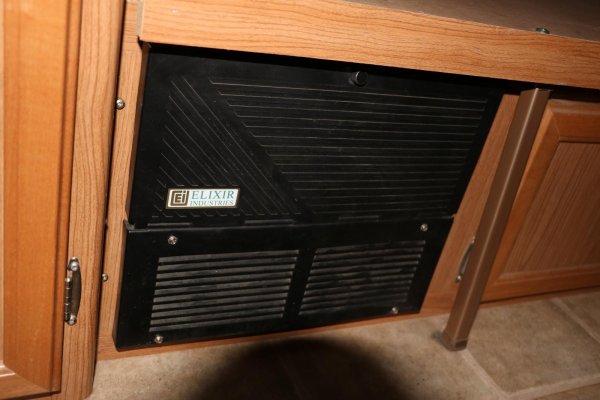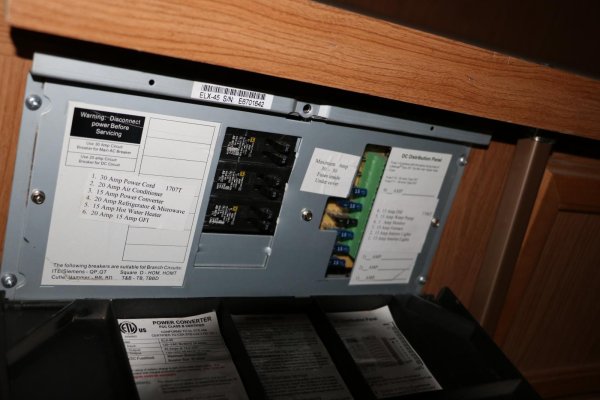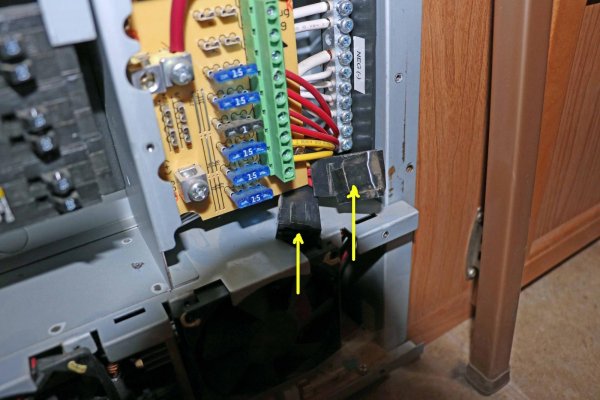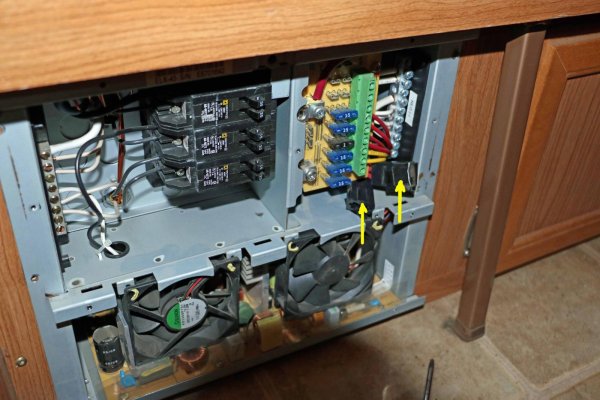Janet and I just returned from a great trip to Crater Lake and Lassen National Parks and except for a problem with the converter in our HiLo, it was without incident.
I discovered, when we were camped at a commercial campground in Nevada so that we could use the Air Conditioner, that our converter was not charging the battery when plugged into shore power. I determined this when I saw the battery voltage around 12.5 after sunset and the solar panels no longer generating power. It should have been somewhat above 13 Volts.
So, after getting home, I investigated and here's what I found: My converter is an Elixir Industries brand, and I understand it is no longer being made. The first picture shows the closed unit, which is mounted to the right of the base of the refrigerator under the couch in my unit. Your location and brand may well be different.
If you unscrew the thumbscrew at the top of the upper hinged panel, it drops down to reveal the DC fuses for the trailer and the AC circuit breakers. That area is covered by a metal plate, held on with three screws that must be removed to gain access to the "innards". This is shown in the second picture.
In the third picture, I removed the plastic, hinged front panel that is held on with four machine screws. I also removed the metal plate I spoke of in the last paragraph. There are two inline 30 Amp fuses in black fuse holders behind the lower edge of the DC fuse panel. They are in the red DC output lines from the converter and they have to be pulled out to inspect their condition. In the picture, they are the black objects at the heads of the two yellow arrows.
The last picture shows a more close view of those fuse holders. The fuses themselves are covered by black electrical tape which conceals them even more, but again, I'm pointing to them with the arrows. You have to unwrap the tape to get to the fuses themselves. They are located at the lower right side of the compartment at the lower edge of the visible fuse panel. They are just above the right side of the fan compartment. I found that both my 30 Amp fuses there were blown, which kills all DC output from the converter. I replaced them and reinstalled everything in reverse order of the disassembly.
So, if your converter suddenly stops charging your batteries, check these fuses before you shell out $100-$200 for a new converter.
In my troubleshooting, I also learned some things about the converter:
I could probably not worry much about a functioning converter since I have an effective solar charging system. But, it's nice to know it's working again. I suspect those fuses may have blown when I raised the top while plugged into shore power at home. If the batteries were low, I think the lifting motor would try to pull the needed current from the converter, and that may have been too much for those fuses.
Hopes this helps someone! I apologize for the shadow at the bottom of all the pictures. My camera has a longish lens, and it shades the flash.
- Jack
I discovered, when we were camped at a commercial campground in Nevada so that we could use the Air Conditioner, that our converter was not charging the battery when plugged into shore power. I determined this when I saw the battery voltage around 12.5 after sunset and the solar panels no longer generating power. It should have been somewhat above 13 Volts.
So, after getting home, I investigated and here's what I found: My converter is an Elixir Industries brand, and I understand it is no longer being made. The first picture shows the closed unit, which is mounted to the right of the base of the refrigerator under the couch in my unit. Your location and brand may well be different.
If you unscrew the thumbscrew at the top of the upper hinged panel, it drops down to reveal the DC fuses for the trailer and the AC circuit breakers. That area is covered by a metal plate, held on with three screws that must be removed to gain access to the "innards". This is shown in the second picture.
In the third picture, I removed the plastic, hinged front panel that is held on with four machine screws. I also removed the metal plate I spoke of in the last paragraph. There are two inline 30 Amp fuses in black fuse holders behind the lower edge of the DC fuse panel. They are in the red DC output lines from the converter and they have to be pulled out to inspect their condition. In the picture, they are the black objects at the heads of the two yellow arrows.
The last picture shows a more close view of those fuse holders. The fuses themselves are covered by black electrical tape which conceals them even more, but again, I'm pointing to them with the arrows. You have to unwrap the tape to get to the fuses themselves. They are located at the lower right side of the compartment at the lower edge of the visible fuse panel. They are just above the right side of the fan compartment. I found that both my 30 Amp fuses there were blown, which kills all DC output from the converter. I replaced them and reinstalled everything in reverse order of the disassembly.
So, if your converter suddenly stops charging your batteries, check these fuses before you shell out $100-$200 for a new converter.
In my troubleshooting, I also learned some things about the converter:
1. The AC devices, such as the Air Conditioner, Microwave, Refrigerator and AC outlets are NOT fed through the converter! That power supply DOES go through the circuit breakers, but the converter is there to convert AC to DC only.
2. If the converter is not functioning, the battery will not receive any charging power when plugged into shore power and the DC devices, such as Water Pump, Furnace, and lights will be powered solely by the batteries. If the battery goes dead, you will lose the use of these components.
3. If the converter IS working, then it will deliver charging current to to batteries and will also supply DC power to the trailer's DC components, since its voltage is higher than battery voltage. In fact, you could remove the battery and the converter should still operate the DC components on its own.
2. If the converter is not functioning, the battery will not receive any charging power when plugged into shore power and the DC devices, such as Water Pump, Furnace, and lights will be powered solely by the batteries. If the battery goes dead, you will lose the use of these components.
3. If the converter IS working, then it will deliver charging current to to batteries and will also supply DC power to the trailer's DC components, since its voltage is higher than battery voltage. In fact, you could remove the battery and the converter should still operate the DC components on its own.
I could probably not worry much about a functioning converter since I have an effective solar charging system. But, it's nice to know it's working again. I suspect those fuses may have blown when I raised the top while plugged into shore power at home. If the batteries were low, I think the lifting motor would try to pull the needed current from the converter, and that may have been too much for those fuses.
Hopes this helps someone! I apologize for the shadow at the bottom of all the pictures. My camera has a longish lens, and it shades the flash.
- Jack
Attachments
Last edited:





